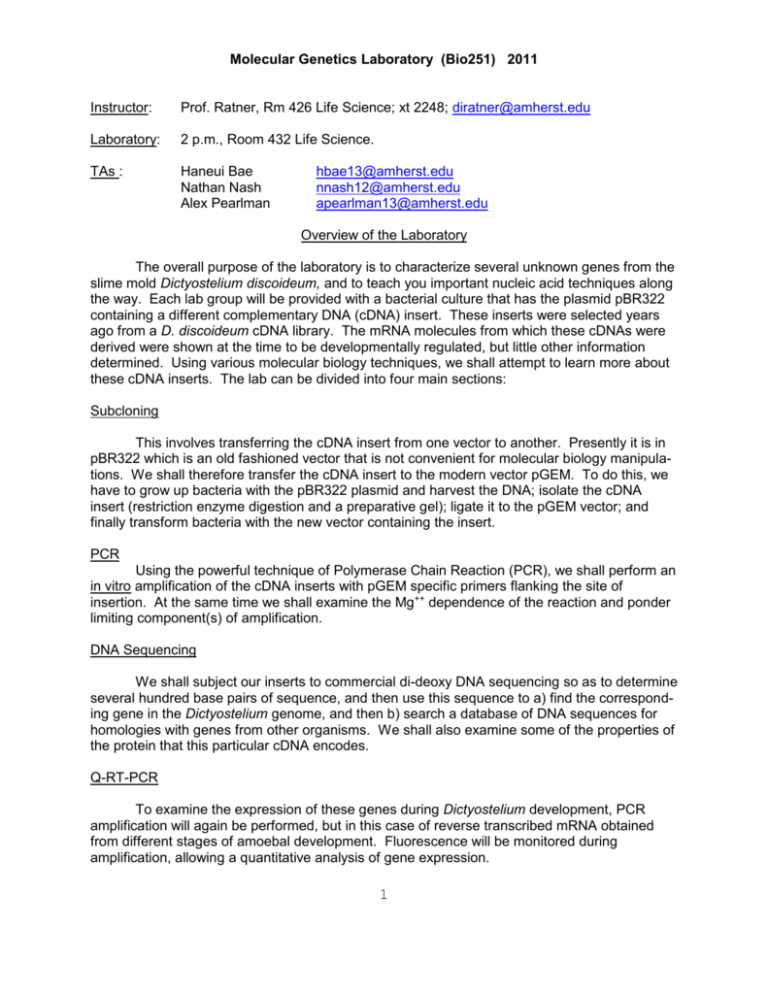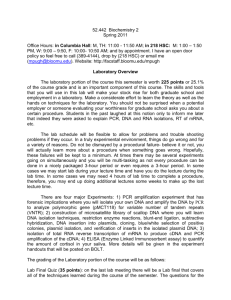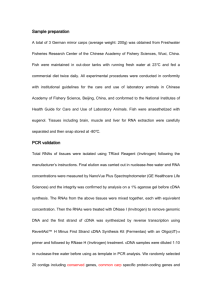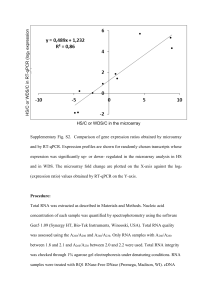Molecular Genetics, Laboratory (Bio25) 2010
advertisement

Molecular Genetics Laboratory (Bio251) 2011 Instructor: Prof. Ratner, Rm 426 Life Science; xt 2248; diratner@amherst.edu Laboratory: 2 p.m., Room 432 Life Science. TAs : Haneui Bae Nathan Nash Alex Pearlman hbae13@amherst.edu nnash12@amherst.edu apearlman13@amherst.edu Overview of the Laboratory The overall purpose of the laboratory is to characterize several unknown genes from the slime mold Dictyostelium discoideum, and to teach you important nucleic acid techniques along the way. Each lab group will be provided with a bacterial culture that has the plasmid pBR322 containing a different complementary DNA (cDNA) insert. These inserts were selected years ago from a D. discoideum cDNA library. The mRNA molecules from which these cDNAs were derived were shown at the time to be developmentally regulated, but little other information determined. Using various molecular biology techniques, we shall attempt to learn more about these cDNA inserts. The lab can be divided into four main sections: Subcloning This involves transferring the cDNA insert from one vector to another. Presently it is in pBR322 which is an old fashioned vector that is not convenient for molecular biology manipulations. We shall therefore transfer the cDNA insert to the modern vector pGEM. To do this, we have to grow up bacteria with the pBR322 plasmid and harvest the DNA; isolate the cDNA insert (restriction enzyme digestion and a preparative gel); ligate it to the pGEM vector; and finally transform bacteria with the new vector containing the insert. PCR Using the powerful technique of Polymerase Chain Reaction (PCR), we shall perform an in vitro amplification of the cDNA inserts with pGEM specific primers flanking the site of insertion. At the same time we shall examine the Mg++ dependence of the reaction and ponder limiting component(s) of amplification. DNA Sequencing We shall subject our inserts to commercial di-deoxy DNA sequencing so as to determine several hundred base pairs of sequence, and then use this sequence to a) find the corresponding gene in the Dictyostelium genome, and then b) search a database of DNA sequences for homologies with genes from other organisms. We shall also examine some of the properties of the protein that this particular cDNA encodes. Q-RT-PCR To examine the expression of these genes during Dictyostelium development, PCR amplification will again be performed, but in this case of reverse transcribed mRNA obtained from different stages of amoebal development. Fluorescence will be monitored during amplification, allowing a quantitative analysis of gene expression. 1 Experimental Timetable, 2011 Subcloning (Wed. dates) 9/7 No lab. 9/14 Lab Wk 1 Preparation of [pBR322+cDNA insert] plasmid DNA. 9/21 Lab Wk 2 Isolation of the cDNA insert. 9/28 Lab Wk 3 Ligation of insert to processed pGEM vector. 10/5 Lab Wk 4 Transformation of bacteria with the ligation product. 10/12 Lab Wk 5 DNA Mini-preps of candidate sub-clones and gel confirmation. Lab report due: Friday, 10/21, in class. Exam I tentatively to be held 10/13, evening. PCR 10/19 Lab Wk 6 Amplification of inserts by PCR. 10/26 Lab Wk 7 Examination of PCR products; discussion of DNA sequencing. Lab report due: Friday, 11/4, in class. Sequence Analysis and Bioinformatics 11/2 Lab Wk 8 Analysis of insert sequences: DR presentation and student investigation. 11/9 Lab Wk 9 Group presentations of individual gene properties. 11/16 No lab. Exam II this week, tentatively 11/17 evening. Q-RT-PCR 11/30 Lab Wk10 Quantitative RT-PCR of developmental time course RNA. 12/7 Lab Wk 11 Analysis of gene expression data. Lab report due: Wednesday, 12/14, in final lecture. 2







